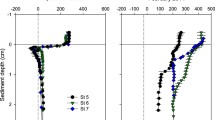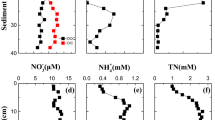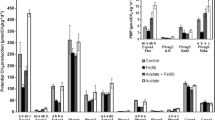Abstract
Incubation experiments were adopted to characterize the rates and pathways of iron reduction and the contributions to anaerobic organic matter mineralization in the upper 0–5 cm of sediments along a landscape-scale inundation gradient in tidal marsh sediments in the Min River Estuary, Southeast China. Similar sediment characteristics, single-species vegetation, varied biomass and bioturbation, distinct porewater pH, redox potential, and electrical conductivity values have resulted in a unique ecogeochemical zonation along the inundation gradient. Decreases in solid-phase Fe(III) and increases in nonsulfidic Fe(II) and iron sulfide were observed in a seaward direction. Porewater Fe2+ was only detected in the upland area. High rates of iron reduction were observed in incubation jars, with significant accumulations of nonsulfidic Fe(II), moderate accumulations of iron sulfides, and negligible accumulations of porewater Fe2+. Most of the iron reduction was microbially mediated rather than coupled to reduced sulfides. Microbial iron reduction accounted for 20–89 % of the anaerobic organic matter mineralization along the inundation gradient. The rate and dominance of microbial iron reduction generally decreased in a seaward direction. The contributions of microbial iron reduction to anaerobic organic matter mineralization depended on the concentrations of bioavailable Fe(III), the spatial distribution of which was significantly related to tidal inundation. Our results clearly showed that microbial iron reduction in the upper sediments along the gradient is highly dependent on spatial scales controlled primarily by tidal inundation.





Similar content being viewed by others
References
Alongi, D.M. 1988. Bacterial productivity and microbial biomass in tropical mangrove sediments. Microbial Ecology 15: 59–79.
Alongi, D.M. 1996. The dynamics of benthic nutrient pools and fluxes in tropical mangrove forests. Journal of Marine Research 54: 123–148.
Anastasiou, C.J., and J.R. Brooks. 2003. Effects of soil PH, redox potential, and elevation on survival of Spartina patens planted at a west Central Florida salt marsh restoration site. Wetlands 23: 845–859.
APHA. 2005. Standard methods for the examination of water and wastewater, 3576–3578. Washington: American Public Health Association (APHA).
Armstrong, W. 1964. Oxygen diffusion from the roots of some British bog plants. Nature 204: 801–802.
Berner, R.A. 1970. Sedimentary pyrite formation. American Journal of Science 268: 1–23.
Bonneville, S., T. Behrends, and P. Van Cappellen. 2009. Solubility and dissimilatory reduction kinetics of iron (III) oxyhydroxides: a linear free energy relationship. Geochimica et Cosmochimica Acta 73: 5273–5282.
Burton, E.D., L.A. Sullivan, R.T. Bush, S.G. Johnston, and A.F. Keene. 2008. A simple and inexpensive chromium-reducible sulfur method for acid-sulfate soils. Applied Geochemistry 23: 2759–2766.
Burton, E.D., R.T. Bush, S.G. Johnston, L.A. Sullivan, and A.F. Keene. 2011. Sulfur biogeochemical cycling and novel Fe–S mineralization pathways in a tidally re-flooded wetland. Geochimica et Cosmochimica Acta 75: 3434–3451.
Cai, H.-Y., L.-F. Zeng, M.-Z. Fang, H.-L. Ge, Y.-Z. Ye, and C.-S. Zeng. 2011. Distribution features and assessment of heavy metal in Tajiaozhou wetland of Minjiang estuary. Journal of Fujian Agriculture and Forestry University (Natural Science Edition) 40: 285–289.
Canfield, D.E. 1989. Reactive iron in marine sediments. Geochimica et Cosmochimica Acta 53: 619–632.
Canfield, D.E., B.B. Jørgensen, H. Fossing, R. Glud, J. Gundersen, N.B. Ramsing, B. Thamdrup, J.W. Hansen, L.P. Nielsen, and P.O. Hall. 1993. Pathways of organic carbon oxidation in three continental margin sediments. Marine Geology 113: 27–40.
Castillo, J., L. Fernández‐Baco, E. Castellanos, C. Luque, M. Figueroa, and A. Davy. 2000. Lower limits of Spartina densiflora and S. maritima in a Mediterranean salt marsh determined by different ecophysiological tolerances. Journal of Ecology 88: 801–812.
Chen, S.-Y. 2011. Research on the adaptability of Cyperus malaccensis and its variety C. malaccensis var. to salt and flooding stress. Guangxi University. 34–37.
Chmura, G.L., S.C. Anisfeld, D.R. Cahoon, and J.C. Lynch. 2003. Global carbon sequestration in tidal, saline wetland soils. Global Biogeochemical Cycles 17: 1111.
Cline, J.D. 1969. Spectrophotometric determination of hydrogen sulfide in natural waters. Limnology and Oceanography 14: 454–458.
Cook, P.L., A.T. Revill, L.A. Clementson, and J.K. Volkman. 2004. Carbon and nitrogen cycling on intertidal mudflats of a temperate Australian estuary. III. Sources of organic matter. Marine Ecology Progress Series 280: 55–72.
Davy, A.J., M.J. Brown, H.L. Mossman, and A. Grant. 2011. Colonization of a newly developing salt marsh: disentangling independent effects of elevation and redox potential on halophytes. Journal of Ecology 99: 1350–1357.
Ferreira, T., X. Otero, P. Vidal-Torrado, and F. Macías. 2007. Effects of bioturbation by root and crab activity on iron and sulfur biogeochemistry in mangrove substrate. Geoderma 142: 36–46.
Froelich, P.N., G. Klinkhammer, M.A.A. Bender, N. Luedtke, G.R. Heath, D. Cullen, P. Dauphin, D. Hammond, B. Hartman, and V. Maynard. 1979. Early oxidation of organic matter in pelagic sediments of the eastern equatorial Atlantic: suboxic diagenesis. Geochimica et Cosmochimica Acta 43: 1075–1090.
Gallagher, J.L., and F.C. Daiber. 1974. Primary production of edaphic algal communities in a Delaware salt marsh. Limnology and Oceanography 19: 390–395.
Genoni, G.P. 1991. Increased burrowing by fiddler crabs Uca rapax (Smith) (Decapoda: Ocypodidae) in response to low food supply. Journal of Experimental Marine Biology and Ecology 147: 267–285.
Giblin, A.E., and R.W. Howarth. 1984. Porewater evidence for a dynamic sedimentary iron cycle in salt marshes. Limnology and Oceanography 29: 47–63.
Gribsholt, B., and E. Kristensen. 2002. Effects of bioturbation and plant roots on salt marsh biogeochemistry: a mesocosm study. Marine Ecology Progress Series 241: 71–87.
Gribsholt, B., and E. Kristensen. 2003. Benthic metabolism and sulfur cycling along an inundation gradient in a tidal Spartina anglica salt marsh. Limnology and Oceanography 48: 2151–2162.
Gribsholt, B., J.E. Kostka, and E. Kristensen. 2003. Impact of fiddler crabs and plant roots on sediment biogeochemistry in a Georgia saltmarsh. Marine Ecology Progress Series 259: 237–251.
Hansel, C.M., C.J. Lentini, Y. Tang, D.T. Johnston, S.D. Wankel, and P.M. Jardine. 2015. Dominance of sulfur-fueled iron oxide reduction in low-sulfate freshwater sediments. The ISME Journal 9: 2400–2412.
Hines, M.E., S.L. Knollmeyer, and J.B. Tugel. 1989. Sulfate reduction and other sedimentary biogeochemistry in a northern New England salt marsh. Limnology and Oceanography 34: 578–590.
Holmboe, N., and E. Kristensen. 2002. Ammonium adsorption in sediments of a tropical mangrove forest (Thailand) and a temperate Wadden Sea area (Denmark). Wetlands Ecology and Management 10: 453–460.
Howarth, R.W. 1993. Microbial processes in salt-marsh sediments. Aquatic Microbiology 239–260.
Howarth, R.W., and J.M. Teal. 1979. Sulfate reduction in a New England salt marsh I. Limnology and Oceanography 24: 999–1013.
Howes, B.L., J.W. Dacey, and G.M. King. 1984. Carbon flow through oxygen and sulfate reduction pathways in salt marsh sediments. Limnology and Oceanography 29: 1037–1051.
Hyacinthe, C., S. Bonneville, and P. Van Cappellen. 2006. Reactive iron (III) in sediments: chemical versus microbial extractions. Geochimica et Cosmochimica Acta 70: 4166–4180.
Hyun, J.-H., A.C. Smith, and J.E. Kostka. 2007. Relative contributions of sulfate- and iron (III) reduction to organic matter mineralization and process controls in contrasting habitats of the Georgia saltmarsh. Applied Geochemistry 22: 2637–2651.
Hyun, J.-H., J.-S. Mok, H.-Y. Cho, S.-H. Kim, K.S. Lee, and J.E. Kostka. 2009. Rapid organic matter mineralization coupled to iron cycling in intertidal mud flats of the Han River estuary, Yellow Sea. Biogeochemistry 92: 231–245.
Jensen, M.M., B. Thamdrup, S. Rysgaard, M. Holmer, and H. Fossing. 2003. Rates and regulation of microbial iron reduction in sediments of the Baltic-North Sea transition. Biogeochemistry 65: 295–317.
Johnston, S.G., A.F. Keene, R.T. Bush, E.D. Burton, L.A. Sullivan, L. Isaacson, A.E. McElnea, C.R. Ahern, C.D. Smith, and B. Powell. 2011. Iron geochemical zonation in a tidally inundated acid sulfate soil wetland. Chemical Geology 280: 257–270.
Johnston, S.G., A.F. Keene, E.D. Burton, R.T. Bush, and L.A. Sullivan. 2012. Quantifying alkalinity generating processes in a tidally remediating acidic wetland. Chemical Geology 304: 106–116.
Joye, S.B., M.L. Mazzotta, and J.T. Hollibaugh. 1996. Community metabolism in microbial mats: the occurrence of biologically-mediated iron and manganese reduction. Estuarine, Coastal and Shelf Science 43: 747–766.
Keller, J.K., P.B. Weisenhorn, and J.P. Megonigal. 2009. Humic acids as electron acceptors in wetland decomposition. Soil Biology and Biochemistry 41: 1518–1522.
King, G.M. 1988. Patterns of sulfate reduction and the sulfur cycle in a South Carolina salt marsh. Limnology and Oceanography 33: 376–390.
King, G.M., and M.A. Garey. 1999. Ferric iron reduction by bacteria associated with the roots of freshwater and marine macrophytes. Applied and Environmental Microbiology 65: 4393–4398.
Koretsky, C.M., P. Van Cappellen, T.J. DiChristina, J.E. Kostka, K.L. Lowe, C.M. Moore, A.N. Roychoudhury, and E. Viollier. 2005. Salt marsh pore water geochemistry does not correlate with microbial community structure. Estuarine, Coastal and Shelf Science 62: 233–251.
Kostka, J.E., and G.W. Luther III. 1994. Partitioning and speciation of solid phase iron in saltmarsh sediments. Geochimica et Cosmochimica Acta 58: 1701–1710.
Kostka, J.E., and G.W. Luther III. 1995. Seasonal cycling of Fe in saltmarsh sediments. Biogeochemistry 29: 159–181.
Kostka, J.E., B. Gribsholt, E. Petrie, D. Dalton, H. Skelton, and E. Kristensen. 2002a. The rates and pathways of carbon oxidation in bioturbated saltmarsh sediments. Limnology and Oceanography 47: 230–240.
Kostka, J.E., A. Roychoudhury, and P. Van Cappellen. 2002b. Rates and controls of anaerobic microbial respiration across spatial and temporal gradients in saltmarsh sediments. Biogeochemistry 60: 49–76.
Kristensen, E., and D.M. Alongi. 2006. Control by fiddler crabs (Uca vocans) and plant roots (Avicennia marina) on carbon, iron, and sulfur biogeochemistry in mangrove sediment. Limnology and Oceanography 51: 1557–1571.
Kristensen, E., and K. Hansen. 1995. Decay of plant detritus in organic-poor marine sediment: production rates and stoichiometry of dissolved C and N compounds. Journal of Marine Research 53: 675–702.
Kristensen, E., and M. Holmer. 2001. Decomposition of plant materials in marine sediment exposed to different electron acceptors (O2, NO −3 and SO 2 −4 ), with emphasis on substrate origin, degradation kinetics, and the role of bioturbation. Geochimica et Cosmochimica Acta 65: 419–433.
Kristensen, E., F. Andersen, N. Holmboe, M. Holmer, and N. Thongtham. 2000. Carbon and nitrogen mineralization in sediments of the Bangrong mangrove area, Phuket, Thailand. Aquatic Microbial Ecology 22: 199–213.
Kristensen, E., S. Bouillon, T. Dittmar, and C. Marchand. 2008. Organic carbon dynamics in mangrove ecosystems: a review. Aquatic Botany 89: 201–219.
Kristensen, E., P. Mangion, M. Tang, M.R. Flindt, M. Holmer, and S. Ulomi. 2011. Microbial carbon oxidation rates and pathways in sediments of two Tanzanian mangrove forests. Biogeochemistry 103: 143–158.
Lovley, D.R., and E.J. Phillips. 1986. Organic matter mineralization with reduction of ferric iron in anaerobic sediments. Applied and Environmental Microbiology 51: 683–689.
Lovley, D.R., and E.J. Phillips. 1987. Competitive mechanisms for inhibition of sulfate reduction and methane production in the zone of ferric iron reduction in sediments. Applied and Environmental Microbiology 53: 2636–2641.
Lovley, D.R., J.D. Coates, E.L. Blunt-Harris, E.J. Phillips, and J.C. Woodward. 1996. Humic substances as electron acceptors for microbial respiration. Nature 382: 445–448.
Lovley, D.R., J.L. Fraga, E.L. Blunt-Harris, L. Hayes, E. Phillips, and J.D. Coates. 1998. Humic substances as a mediator for microbially catalyzed metal reduction. Acta Hydrochimica et Hydrobiologica 26: 152–157.
Luo, M., C.-S. Zeng, C. Tong, J.-F. Huang, Q. Yu, Y.-B. Guo, and S.-H. Wang. 2014. Abundance and speciation of iron across a subtropical tidal marsh of the Min River Estuary in the East China Sea. Applied Geochemistry 45: 1–13.
Luo, M., C.-S. Zeng, C. Tong, J.-F. Huang, Q. Yu, Y.-B. Guo, and S.-H. Wang. 2015. Kinetics of chemical and microbial iron reduction along an inundation gradient in a tidal marsh of the Min River Estuary, southeastern China. Geomicrobiology Journal 32: 635–647.
Luther III, G.W., J.E. Kostka, T.M. Church, B. Sulzberger, and W. Stumm. 1992. Seasonal iron cycling in the salt-marsh sedimentary environment: NO −3 the importance of ligand complexes with Fe (II) and Fe (III) in the dissolution of Fe (III) minerals and pyrite, respectively. Marine Chemistry 40: 81–103.
Luther III, G.W., P.A. Shellenbarger, and P.J. Brendel. 1996. Dissolved organic Fe (III) and Fe (II) complexes in salt marsh porewaters. Geochimica et Cosmochimica Acta 60: 951–960.
Mackin, J.E., and R.C. Aller. 1984. Ammonium adsorption in marine sediments I. Limnology and Oceanography 29: 250–257.
Moeslundi, L., B. Thamdrup, and B.B. Jørgensen. 1994. Sulfur and iron cycling in a coastal sediment: radiotracer studies and seasonal dynamics. Biogeochemistry 27: 129–152.
Neubauer, S.C., K. Givler, S. Valentine, and J.P. Megonigal. 2005. Seasonal patterns and plant-mediated controls of subsurface wetland biogeochemistry. Ecology 86: 3334–3344.
Nevin, K.P., and D.R. Lovley. 2002. Mechanisms for Fe (III) oxide reduction in sedimentary environments. Geomicrobiology Journal 19: 141–159.
Ortega, T., R. Ponce, J. Forja, and A. Gómez-Parra. 2005. Fluxes of dissolved inorganic carbon in three estuarine systems of the Cantabrian Sea (north of Spain). Journal of Marine Systems 53: 125–142.
Postma, D., and R. Jakobsen. 1996. Redox zonation: equilibrium constraints on the Fe (III)/SO 2 −4 -reduction interface. Geochimica et Cosmochimica Acta 60: 3169–3175.
Roden, E.E., and R.G. Wetzel. 2002. Kinetics of microbial Fe (III) oxide reduction in freshwater wetland sediments. Limnology and Oceanography 47: 198–211.
Roden, E.E., and J.M. Zachara. 1996. Microbial reduction of crystalline iron (III) oxides: influence of oxide surface area and potential for cell growth. Environmental Science & Technology 30: 1618–1628.
Roden, E.E., A. Kappler, I. Bauer, J. Jiang, A. Paul, R. Stoesser, H. Konishi, and H. Xu. 2010. Extracellular electron transfer through microbial reduction of solid-phase humic substances. Nature Geoscience 3: 417–421.
Rooney-Varga, J.N., B.R.S. Genthner, R. Devereux, S.G. Willis, S.D. Friedman, and M.E. Hines. 1998. Phylogenetic and physiological diversity of sulphate-reducing bacteria isolated from a salt marsh sediment. Systematic and Applied Microbiology 21: 557–568.
Rosenfeld, J.K. 1979. Ammonium adsorption in nearshore anoxic sediments I. Limnology and Oceanography 24: 356–364.
Santos-Echeandía, J., C. Vale, M. Caetano, P. Pereira, and R. Prego. 2010. Effect of tidal flooding on metal distribution in pore waters of marsh sediments and its transport to water column (Tagus Estuary, Portugal). Marine Environmental Research 70: 358–367.
Sarazin, G., G. Michard, and F. Prevot. 1999. A rapid and accurate spectroscopic method for alkalinity measurements in sea water samples. Water Research 33: 290–294.
Seeberg-Elverfeldt, J., M. Schlüter, T. Feseker, and M. Kölling. 2005. Rhizon sampling of pore waters near the sediment/water interface of aquatic systems. Limnology and Oceanography: Methods 3: 361–371.
Spiteri, C., P. Regnier, C.P. Slomp, and M.A. Charette. 2006. pH-dependent iron oxide precipitation in a subterranean estuary. Journal of Geochemical Exploration 88: 399–403.
Straub, K.L., M. Benz, and B. Schink. 2001. Iron metabolism in anoxic environments at near neutral pH. FEMS Microbiology Ecology 34: 181–186.
Stumm, W., J.J. Morgan, and J.I. Drever. 1996. Aquatic chemistry. Journal of Environmental Quality 25: 1162.
Taillefert, M., S. Neuhuber, and G. Bristow. 2007. The effect of tidal forcing on biogeochemical processes in intertidal salt marsh sediments. Geochemical Transactions 8: 1–15.
Thamdrup, B., and D.E. Canfield. 1996. Pathways of carbon oxidation in continental margin sediments off central Chile. Limnology and Oceanography 41: 1629–1650.
Thamdrup, B., and D.E. Canfield. 2000. Benthic respiration in aquatic sediments. In Methods in Ecosystem Science, 86–103: Springer.
Thamdrup, B., K. Finster, J.W. Hansen, and F. Bak. 1993. Bacterial disproportionation of elemental sulfur coupled to chemical reduction of iron or manganese. Applied and Environmental Microbiology 59: 101–108.
Thamdrup, B., R.N. Glud, and J.W. Hansen. 1994. Manganese oxidation and in situ manganese fluxes from a coastal sediment. Geochimica et Cosmochimica Acta 58: 2563–2570.
Tong, C., W.-Q. Wang, J.-F. Huang, V. Gauci, L.-H. Zhang, and C.-S. Zeng. 2012. Invasive alien plants increase CH4 emissions from a subtropical tidal estuarine wetland. Biogeochemistry 111: 677–693.
Wang, F., S.K. Juniper, S.L.P. Pelegrí, and S.A. Macko. 2003. Denitrification in sediments of the Laurentian Trough, St. Lawrence Estuary, Quebec, Canada. Estuarine, Coastal and Shelf Science 57: 515–522.
Weiss, J.V., D. Emerson, and J.P. Megonigal. 2004. Geochemical control of microbial Fe (III) reduction potential in wetlands: comparison of the rhizosphere to non-rhizosphere soil. FEMS Microbiology Ecology 48: 89–100.
Weiss, J.V., D. Emerson, and J.P. Megonigal. 2005. Rhizosphere iron (III) deposition and reduction in a Juncus effusus L.-dominated wetland. Soil Science Society of America Journal 69: 1861–1870.
Zhang, L.-H., and R.-S. Wang. 2011. Composition and profile distribution of humus in the Kandelia candel wetlands of Min River estuary. Yunnan Geographic Environment Research 23: 5–10.
Acknowledgments
We sincerely thank Mrs Hong for the POC and PON analyses, Mr Zhang for the field and laboratory analyses, and three anonymous reviewers for their valuable comments and suggestions, which helped improve the manuscript. We thank LetPub and American Journal Experts for its linguistic assistance during the preparation of this manuscript. This work was financially supported by the National Science Foundation of China (Grant No. 41501252) and the Scientific Research Foundation of Fuzhou University (XRC-1521).
Author information
Authors and Affiliations
Corresponding author
Additional information
Communicated by Bradley Eyre
Rights and permissions
About this article
Cite this article
Luo, M., Zeng, CS., Tong, C. et al. Iron Reduction Along an Inundation Gradient in a Tidal Sedge (Cyperus malaccensis) Marsh: the Rates, Pathways, and Contributions to Anaerobic Organic Matter Mineralization. Estuaries and Coasts 39, 1679–1693 (2016). https://doi.org/10.1007/s12237-016-0094-0
Received:
Revised:
Accepted:
Published:
Issue Date:
DOI: https://doi.org/10.1007/s12237-016-0094-0




